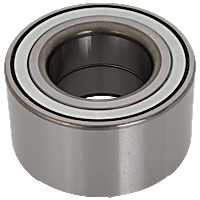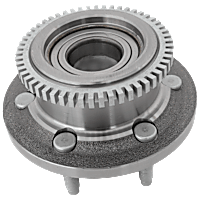You’re driving along on a warm, sunny day listening to your favorite song. Life is good. But when you turn down the radio, you hear an unusual noise that coincides with the rotation of the tires. What could it be?
A bad wheel bearing is one possibility. If you hear a strange wheel bearing sound, you should check the parts as early as possible.
What Does a Bad Wheel Bearing Sound Like?
While you should never want to hear the sound of a wheel bearing going out, it’s important to recognize the noise. Most people describe a bad wheel bearing as making a growling or rumbling noise (the sound is often mistaken for worn tires). Also, in some cases, a bad bearing may make a high-pitched grinding or squealing sound.
In either case, the frequency of the bad wheel bearing sound will correspond to the rotation of the tires. The sound will also increase with vehicle speed (though it may go away at a certain point) and may get louder when turning in one direction or the other.
How to Tell if Your Wheel Bearing is Bad
Your car has a lot of rotating parts, which makes it hard to distinguish a bad wheel bearing from many other problems. Paying attention to when the noise occurs may help you narrow down your options.

Obviously, a faulty wheel bearing will only make noise when you’re driving. So, if you hear the sound when the vehicle is stopped, you can rule out the wheel bearings altogether. It’s also important to note that wheel bearing noise will basically sound the same no matter what type of surface you’re traveling over.

Tire noise, however, will usually change with the road surface.
Furthermore, in most cases, you’ll hear a noisy wheel bearing regardless of whether you’re accelerating or decelerating. On the other hand, some drivetrain noises—but not all—will change upon acceleration or deceleration.
At the end of the day, it can be difficult to distinguish a bad wheel bearing from other problems. That’s why it’s important to perform further diagnostic work before jumping to conclusions. Otherwise, you may end up replacing a wheel bearing only to find the problem was something else.
You’ll also want to keep in mind that not all bad wheel bearings make noise. Some worn-out bearings will exhibit excessive lateral movement, without making any abnormal sounds.
How to Check for Bad Wheel Bearings
There are a lot of other problems that can mimic the sound of a bad wheel bearing. To be sure that one of your car’s wheel bearings is to blame, you’ll need to do some additional diagnostic work.
Some of the methods used to pinpoint a bad wheel bearing include:
- Checking for play by rocking the wheel/tire assembly
- Inspecting for roughness
- Listening for wheel bearing noise with a stethoscope
- Monitoring for excess heat
- Checking for play using a dial indicator
You can determine which wheel bearing needs replacement by testing each wheel with the following method. Raise your vehicle with a jack stand until it’s high enough for the tires to spin. Grab the tire you want to test by its 6 and 12 o’clock positions. Spin the wheel and check for any wiggling. Listen for wheel bearing noise as well.
To learn more about each of these methods, check out our in-depth article on diagnosing a faulty hub and bearing assembly. You’ll quickly pick up the tips and tricks on how to check for a bad wheel bearing.

Signs of Wheel Bearing Failure
You already know a faulty wheel bearing can cause noise. But did you know that it can cause other issues as well? A bad bearing may allow the wheel hub to exhibit excessive movement. Plus, the internal bearing components will experience increased friction. As a result, you may notice your vehicle displaying the following problems:
- Growling/humming noise
- Vibration when driving
- Pulsation when braking
- Irregular or abnormal tire wear
- Illuminated warning lights
If you’d like to know more, read our article on wheel hub assembly symptoms.

Can You Drive with a Bad Wheel Bearing?
You might be wondering whether you can continue driving with a bad wheel bearing. And the answer is—absolutely not. In some cases, a failed wheel bearing can cause you to lose a wheel while driving, which can have potentially deadly consequences.
So, if you think you hear the rumble of a bad wheel bearing, be sure to get your vehicle repaired immediately. Your safety depends on it.
What Can Happen if You Have a Bad Wheel Bearing?
As was mentioned above, if you ignore a bad wheel bearing, you could end up losing a wheel. That’s the worst-case scenario, but there are other undesirable consequences, as well. A bad wheel bearing can cause abnormal tire wear, a pulsation while driving—even problems with the ABS system.
If wheel bearing noises and other symptoms of a bad wheel bearing appear while you’re driving, reduce your speed at a steady rate. Refrain from turning too fast to avoid damaging the bearing.
So, once again, if you think you’ve got a bad wheel bearing, get the problem fixed right away by either going to a mechanic, or by purchasing a replacement bearing and fixing it yourself.
How to Use the ABS
To use your ABS, you’ll have to apply firm pressure to the brake pedal. Make sure you don’t pump the pedal and keep your foot firmly planted on the pedal. Then, steer your vehicle to a safe spot where you can park if necessary.
If your ABS fails and your tires start to skid, you can pump the brake pedal.
What Happens When the ABS Fails?
A faulty ABS will make your vehicle’s brake system unpredictable. The ABS can suddenly activate and pump your brakes even though it’s unnecessary. In some cases, it can start making strange clicking noises.
Does ABS Decrease My Stopping Distance?
In some cases, yes. A 4-wheel ABS can increase your stopping distance if you’re driving on icy roads and other slippery surfaces. In most cases, however, it will activate and pump the brakes much faster than you could, immediately stopping the vehicle within a short stopping distance.
Should I Still Pump My Brakes When Using a Car With ABS?
The only time you should pump the brake pedal when driving a car with ABS is when the system suddenly fails. If it’s working perfectly fine, however, just keep a firm pressure on the brake. This will allow the ABS to work much better.
What’s the Difference Between ABS and Rear-Wheel-Only ABS?
Most passenger cars and minivans come with a 4-wheel ABS, which also aids them in steering their vehicle during an emergency. In contrast, rear-wheel-only ABS is specifically designed to prevent pickup trucks, vans, and SUVs from skidding across slippery surfaces.
Products Mentioned in this Guide
Any information provided on this Website is for informational purposes only and is not intended to replace consultation with a professional mechanic. The accuracy and timeliness of the information may change from the time of publication.


 Wheel Bearing
Wheel Bearing
 Wheel Hub
Wheel Hub





























